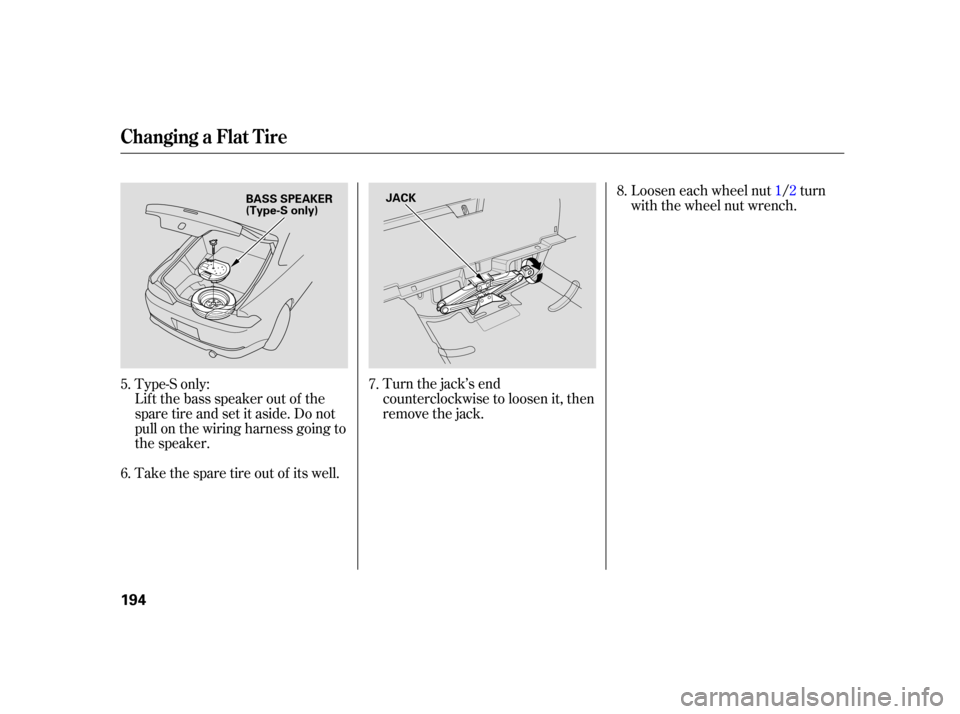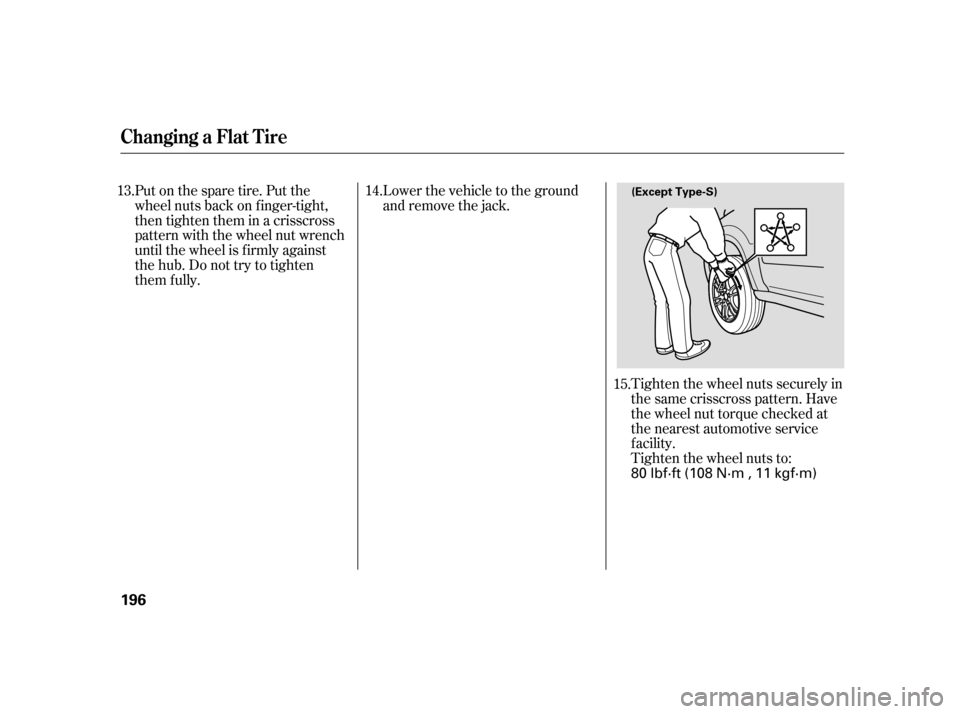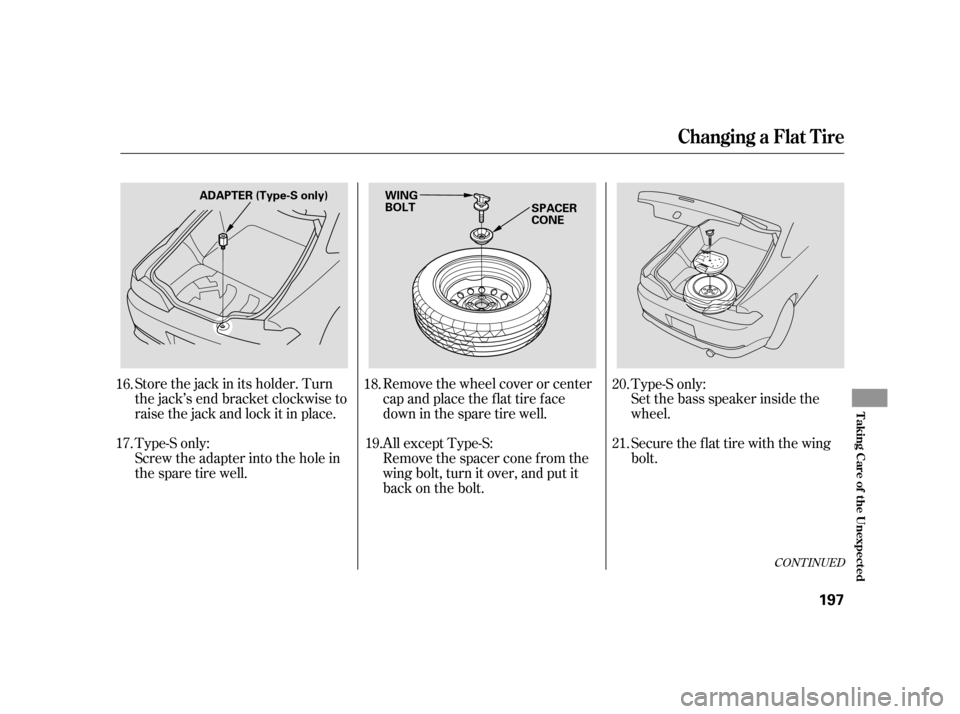Acura RSX 2005 Owner's Manual
Manufacturer: ACURA, Model Year: 2005, Model line: RSX, Model: Acura RSX 2005Pages: 243, PDF Size: 3.42 MB
Page 191 of 243

190
Page 192 of 243

This section covers the more
common problems that motorists
experience with their vehicles. It
gives you inf ormation about how to
safely evaluate the problem and what
to do to correct it. If the problem has
stranded you on the side of the road,
you may be able to get going again.
If not, you will also f ind instructions
on getting your vehicle towed.......................
Compact Spare Tire .192
....................
Changing a Flat Tire .193
.............
If the Engine Won’t Start . 198
................................
Jump Starting .200
..............
If the Engine Overheats . 202
.........
Low Oil Pressure Indicator . 204
..........
Charging System Indicator . 204
.......
Malf unction Indicator Lamp . 205
...............
Brake System Indicator . 206
..................
Closing the Moonroof . 207
..............................................
Fuses .208
..........................
Fuse Locations .211
......................
Emergency Towing .213
Taking Care of the Unexpected
T aking Care of t he Unexpect ed
191
Page 193 of 243

Use the compact spare tire as a
temporary replacement only. Get
your regular tire repaired or replaced,
and put it back on your vehicle as
soon as you can.
Check the inf lation pressure of the
compact spare tire every time you
check the other tires. It should be
inf lated to:
Follow these precautions:Never exceed 50 mph (80 km/h)
under any circumstances.
This tire gives a harsher ride and
less traction on some road sur-
f aces. Use greater caution while
driving. Do not mount snow chains on the
compact spare tire.
Do not use your compact spare
tire on another vehicle unless it is
thesamemakeandmodel.
Replace the tire when you can see
the tread wear indicator bars. The
replacement should be the same size
and design tire, mounted on the
samewheel.Thesparetireisnot
designed to be mounted on a regular
wheel, and the spare wheel is not
designed f or mounting a regular tire.
Compact Spare Tire
192
INDICATOR LOCATION MARK
TREAD WEAR INDICATOR BAR
60 psi (420 kPa , 4.20 kgf/cm)
Page 194 of 243

CONT INUED
If you have a f lat tire while driving,
stop in a saf e place to change it.
Drive slowly along the shoulder until
you get to an exit or an area to stop
that is far away from the traffic lanes.Park the vehicle on f irm, level, and
non-slippery ground. Put the
transmission in Park (automatic)
or Reverse (manual). Apply the
parking brake. If you are towing a
trailer, unhitch the trailer.Turn on the hazard warning lights,
andturntheignitionswitchto
LOCK (0). Have all the
passengers get out of the vehicle
while you change the tire.
Open the hatch. Pull up the f loor
mat and remove the spare tire
cover.
Unscrew the wing bolt.
1. 2.
3.
4.
Changing a Flat T ire
T aking Care of t he Unexpect ed
193
TOOL KIT
JACK
The vehicle can easily roll off
the jack, seriously injuring
anyone underneath.
Follow the directions for
changing a tire exactly, and
never get under the vehicle
when it is supported only by the
jack.
Page 195 of 243

Lift the bass speaker out of the
spare tire and set it aside. Do not
pull on the wiring harness going to
the speaker.
Take the spare tire out of its well.Turn the jack’s end
counterclockwise to loosen it, then
remove the jack.Loosen each wheel nut
1/2turn
with the wheel nut wrench.
5.
6. 7.8.
Type-S only:
Changing a Flat T ire
194
BASS SPEAKER
(Type-S only) JACK
Page 196 of 243

CONT INUED
Place the jack under the jacking
point. Turn the end bracket
clockwise until the top of the jack
contacts the jacking point. Make
sure the jacking point tab is
resting in the jack notch.Remove the wheel nuts, then
remove the flat tire. Place the flat
tire on the ground with the outside
surface facing up.Bef ore mounting the spare tire,
wipeanydirtoff themounting
surface of the wheel and hub with
a clean cloth. Wipe the hub
carefully;itmaybehotfrom
driving.
Use the extension and the wheel
nut wrench as shown to raise the
vehicle until the f lat tire is of f the
ground.
9.
10.
11. 12.
Changing a Flat T ire
T aking Care of t he Unexpect ed
195
JACKING POINT
EXTENSION
WHEEL NUT
WRENCH
Page 197 of 243

Tighten the wheel nuts securely in
the same crisscross pattern. Have
the wheel nut torque checked at
the nearest automotive service
f acility.
Tighten the wheel nuts to:
Put on the spare tire. Put the
wheel nuts back on f inger-tight,
then tighten them in a crisscross
pattern with the wheel nut wrench
until the wheel is f irmly against
the hub. Do not try to tighten
them f ully.
Lower the vehicle to the ground
and remove the jack.
15.
13.
14.
Changing a Flat T ire
196
(Except Type-S)
80 lbf·ft (108 N·m , 11 kgf·m)
Page 198 of 243

Store the jack in its holder. Turn
the jack’s end bracket clockwise to
raisethejackandlockitinplace.
Screw the adapter into the hole in
the spare tire well.Remove the wheel cover or center
cap and place the flat tire face
down in the spare tire well.
Set the bass speaker inside the
wheel.
Secure the f lat tire with the wing
bolt.
Remove the spacer cone f rom the
wing bolt, turn it over, and put it
back on the bolt.
18.
16.
17. 20.
21.
Type-S only: Type-S only:
19.All except Type-S:
CONT INUED
Changing a Flat T ire
T aking Care of t he Unexpect ed
197
ADAPTER (Type-S only) WING BOLTSPACER
CONE
Page 199 of 243

Store the tool kit.
Store the wheel cover or center
cap in the cargo area. Make sure it
will not get scratched or damaged.Diagnosing why the engine won’t
start f alls into two areas, depending
on what you hear when you turn the
key to START (III):
You hear nothing, or almost
nothing. The engine’s starter
motor does not operate at all, or
operates very slowly.
You can hear the starter motor
operating normally, or the starter
motor sounds like it is spinning
f aster than normal, but the engine
does not start up and run. When you turn the ignition switch to
START (III), you do not hear the
normal noise of the engine trying to
start. You may hear a clicking sound
or series of clicks, or nothing at all.
Check these things:
Check the transmission interlock.
If you have a manual transmission,
the clutch pedal must be pushed
all the way to the f loor or the
starter will not operate. With an
automatic transmission, it must be
in Park or Neutral.
Turn the ignition switch to ON (II).
Turn on the headlights, and check
their brightness. If the headlights
areverydimordonotcomeonat
all, the battery is discharged. See on page .
Reinstall the f loor mat and spare
tire cover, then close the hatch.
22.
23.
24.
200
Changing a Flat Tire, If the Engine Won’t Start
If the Engine Won’t StartNothing Happens or the Starter
Motor Operates Very Slowly
Jump Starting
198
Loose items can fly around the
interior in a crash and could
seriously injure the occupants.
Store the wheel, jack, and tools
securely before driving.
Page 200 of 243

Turn the ignition switch to START
(III). If the headlights do not dim,
check the condition of the f uses. If
thefusesareOK,thereis
probably something wrong with
the electrical circuit f or the
ignition switch or starter motor.
You will need a qualif ied
technician to determine the
problem (see
on page ).In this case, the starter motor’s
speed sounds normal, or even f aster
than normal, when you turn the
ignition switch to START (III), but
the engine does not run.
Are you using a properly coded
key? An improperly coded key will
cause the immobilizer system
indicator in the instrument panel
to blink rapidly (see page ).
Are you using the proper starting
procedure? Ref er to on page .
Do you have f uel? Check the f uel
gauge; the low f uel indicator may
not be working. There may be an electrical
problem, such as no power to the
f uel pump. Check all the f uses
(see page ).
If youfindnothingwrong,youwill
need a qualif ied technician to f ind
the problem. See on page .
If the headlights dim noticeably or
go out when you try to start the
engine, either the battery is
discharged or the connections are
corroded. Check the condition of
the battery and terminal
connections (see page ). You
canthentryjumpstartingthe
vehicle from a booster battery
(see page ). 200 188 135
213
65208
213
If theEngineWon’tStart
Emergency T owing T he Starter Operates Normally
Starting the
Engine Emergency
Towing
T aking Care of t he Unexpect ed
199